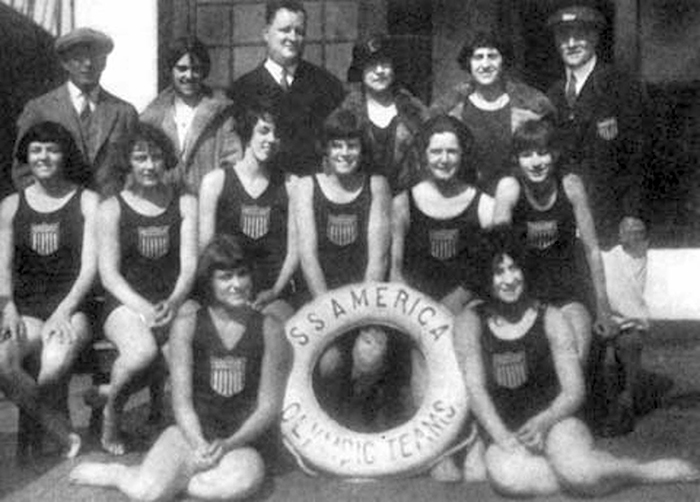Charlotte Epstein (1884 – 1938) poses in the back row, second from right, with members of the 1924 American Olympic team. Epstein was the founder of the Women’s Swimming Association, and team manager of the American women’s swim team at the 1920 Olympics, the first in which women were allowed to compete, and at two other Olympic Games. She is shown here, back row, second from right, with the 1924 American Olympic team. Photo courtesy of the International Swimming Hall of Fame.
O mermaid bold, long may you hold the wreath you’ve won by swimming, And spoil for gents their arguments Regarding Votes for Wimmen!” To a Lady Swimmer– William F. Kirk 1914.
By MARILYN SHAPIRO
I love to swim. So it is no surprise that I spent much of the first week of the 2024 Paris Olympics watching the swim competition. I cheered on Team USA as they won 25 medals in the 39 events in the Paris La Défense Arena. As I yelled, “Go! Go! Go!” at the screen during the 1500 freestyle, Katie Ledecky’s last race, my granddaughter admonished me. “Your screaming isn’t going to make a difference,” she said. Hey! Maybe it did! Ledecky won her 14th medal as part of her participation over four Olympics.
J. Woman Fights Assumptions
Ledecky, Torri Huske, Jenny Thompson, Dara Torres, Janet Evans, Donna De Varona, and every woman who has dived into an Olympic pool have a Jewish woman to thank. Charlotte “Eppy” Epstein, considered the “mother of women’s swimming in America.” was not an exceptional swimmer herself but she believed that athletic competition was as important for women as it was for men. Her determination and leadership had an impact not only the sport of swimming, but also how women perceived their own bodies and their place in the world.
Until Epstein transformed women’s swimming, women were discouraged from swimming or, for that fact, from “breaking a sweat anywhere but in the kitchen.” Glenn Stout wrote in his 2009 book, Young Woman and the Sea, How Trudy Ederle Conquered the English Channel and Inspired the World. Social bias against women’s participation in sports was the norm. This was maybe best expressed by Olympic founder Baron Pierre de Coubertin of France, who thought women’s competition in athletics was “physically dangerous for such delicate flowers and morally offensive.”
Customs And Costumes
Even if they could get in the water, they were hindered by the standard female bathing costumes. Kristin Toussaint described them in a 2015 Boston Globe article: “black, knee-length, puffed-sleeved wool dresses worn over bloomers with long black stockings, bathing slippers, and even ribboned swim caps.” In 1907, Annette Kellerman, an Australian competitive swimmer and vaudeville star, was arrested for indecency by Massachusetts’s police for wearing a one-piece bathing suit that ended in shorts above her knees. “Kellerman may have been thoroughly covered,” Toussaint said, “but to her fellow bathers, she may as well have been naked.”
Epstein changed the narrative in 1914 when she founded National Women’s Life Saving League, which offered the “delicate flowers” a place to swim and take lessons. Using negotiating skills she learned through her job as a court reporter, she convinced the Amateur Athletic Union (AAU) to permit women to register with their organization for the first time and to sponsor competitive women’s meets. According to Stout, Epstein worked “behind the scenes…, extolling the advantages of having a women’s swim association managed by women while deftly praising the example set by the AAU as an organizing body without peer—essentially killing the organization—and its male overseers—with kindness.”
Advancing The Sport
In 1917, she struck out on her own, creating the New York City Women’s Swimming Association. (WSA), to further advance the sport. She successfully battled the U.S. Olympic Committee, enabling American female swimmers and divers to compete in the Olympics in Antwerp, Belgium. (Through her efforts, swimming dresses and bloomers were replaced with outfits closer in style to Annette Kellerman’s.) The success of the American women’s swim team led to the inclusion of track and field and other sports for women in future Olympic Games.
Epstein served as the women’s swimming team manager for the 1920, 1924, and 1932 Olympics. Her swimmers and divers dominated the games, holding 51 world records over the course of her 22 years coaching. Her protégés included Eleanor Holm, Aileen Riggin, Helen Wainwright, and Gertrude Ederle, the first woman to swim the English Channel. Epstein also served as chairwoman of the national AAU women’s swimming committee.
Champion For Women
Her Jewish roots became part of her legacy. The WSA team swam at the Young Women’s Hebrew Association of New York for national championship meets in the 1920s. In 1935, Epstein served as chairwoman of the swimming committee of the Second Maccabiah Games. In 1936, Epstein refused to attend the Berlin Olympic Games and withdrew from the American Olympic Committee in protest at U.S. participation in the “Nazi Olympics.”
During her lifetime, Epstein also used her position to battle for women’s suffrage, staging “suffrage swim races” with her teammates, and fought for further bathing suit reform, distance swims, and additional competitive events for women. Epstein’s major influence on swimming continued until her death in 1938, just short of her 54th birthday. She was inducted into the International Swimming Hall of Fame and the International Jewish Sport Hall of Fame.
“By motivating young women to follow their passions in a sport that did not yet fully accept them, Epstein truly changed the way women thought about swimming,” according to Women in Swimming. “ Her impact did not end in the pool; once women gained freedom over their bodies in sports, they were better able to achieve liberation in other facets of society.”
Thank you
On Wednesday, July 31, after binging on a morning of Olympic events being broadcast on NBC, I headed for the small pool in our Colorado rental complex. I swam 1,500 meters in over an hour, approximately four times Ledecky’s time of 15:30.02 minutes in Paris earlier that day. I may not be setting any world records, but I too am a beneficiary of efforts of the small Jewish powerhouse from Brooklyn. I did not fear being arrested for wearing a TYR swimsuit, and no one feared that this “delicate flower” could not survive the multiple laps. I tip my Speedo swim cap to you, Eppy!
Added note: Disney Plus recently released “Young Woman and the Sea.” Based on Glenn Stout’s 2009 book, the movie tells the story of Epstein’s most well known protégé, Gertrude Ederle, the first woman who swam the English Channel. Sian Clifford, who played Epstein, said the movie is “a beautiful, inspiring story that should have been told before.” Not only did Larry, my husband, and I enjoy the movie; our nine-year-old granddaughter loved it as well.
Sources:
Borish, Linda. “The Cradle of American Champions, Women Champions Swim Champions’: Charlotte Epstein, Gender and Jewish Identity, and the Physical Emancipation of Women in Aquatic Sports.” www.researchgate.net. March 2004.
“Charlotte ‘Eppy’ Epstein.” International Jewish Sports Hall of Fame. Website: http://www.jewishsports.net/BioPages/CharlotteEppyEpstein.htm
Charlotte Epstein. Jewish Virtual Library. Website: https://www.jewishvirtuallibrary.org/epstein-charlotte
“Sian Clifford Spills Secrets on ‘Young Woman and the Sea’ at Premiere.” Website: https://www.youtube.com/watch?v=F3sXvDepTr8
Stout, Glenn. Young Woman and the Sea, How Trudy Ederle Conquered the English Channel and Inspired the World. Houghton Mifflin Harcourt. 2009.
Toussaint, Kristin. “This woman’s one-piece bathing suit got her arrested in 1907.” July 2, 2015. https://www.boston.com/news/history/2015/07/02/this-womans-one-piece-bathing-suit-got-her-arrested-in-1907/







